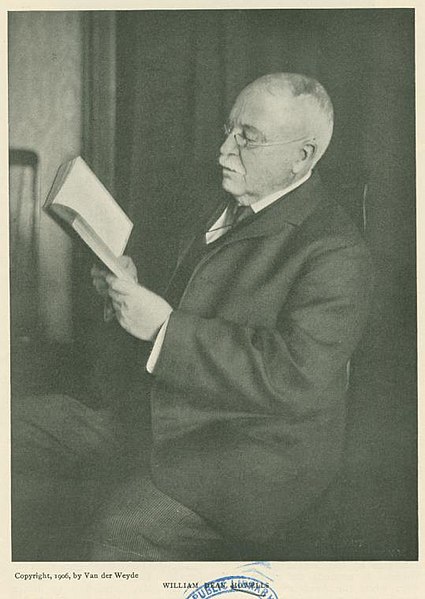23 William Dean Howells (1837 – 1920)
Amy Berke; Robert Bleil; and Jordan Cofer

William Dean Howells was born in Martinsville, Ohio, in 1837. Howells’s father was a newspaper editor, and Howells learned the skills of a writer and editor under his father’s guidance. Howells continued to work in publishing until he secured a position with The Atlantic Monthly in Massachusetts in 1866, where he served as Assistant Editor. In 1871, Howells was promoted to Editor of the magazine, and he continued working in that position until 1881. Howells, along with Mark Twain
and Henry James, became one of the main advocates and theorists of American Literary Realism, a style of writing that reacted against the previous Romantic era’s perceived literary excesses. Instead, the Realists praised the American novel that presented characters, setting, and action as “true to life.” Howells’s scope of influence on a generation of American writers can be seen in his endorsement of Henry James, Mark Twain, Sarah Orne Jewett, Mary E. Wilkins Freeman, Charles Chesnutt, Hamlin Garland, Frank Norris, and Stephen Crane, to name but a few. Howells eventually became known as the “Dean of American Letters” and today is considered the father of American Literary Realism. Howells produced his own creative work during his lifetime and is best remembered for two fine novels in the Realist tradition: A Modern Instance (1882) and The Rise of Silas Lapham (1885), as well as a host of short stories and theoretical works on Realism. Howells lived a long, productive life, dying in 1920 at the age of 83.
With Mark Twain and Henry James, Howells wrote and spoke prolifically about Realism and its superiority over the earlier Romantic style practiced by authors such as James Fenimore Cooper. In Criticism and Fiction (1891), Howells set forth his views on Realism, arguing that fiction should be “life-like” and “true to human experience.” Howells, along with Twain in particular, rejected the idealistic, the fantastic, the heroic, and the exaggerated, preferring instead simplicity and honesty in fiction writing. Although there were some elements of reality that Howells preferred authors avoid, particularly the salacious and the sensational, Howells consistently privileged realism over idealism in his theory of writing fiction. Howells’s own literary work espoused these principles. A Modern Instance (1882) and The Rise of Silas Lapham (1885), two of his most famous novels, both deal with ordinary middle class people facing plausible personal conflicts in a contemporary setting. The characters are multi-faceted and dimensional, and the resolutions for the main characters are left open, as is often the case in “real life.” In his famous short story “Editha,” Howells explores a young woman’s patriotic impulses in contrast to the reality of war. He sets the story on the eve of the Spanish-American War, when nationalism was soaring and the desire for war with Spain was strong. Editha, a young woman who lives in the “ideal,” is caught up in the patriotic fervor, taking her understanding of the heroic from Romantic ideas that glorify war. She insists her fiancé George enlist in the army, imagining him as a heroic warrior leaving to fight for her. The story contrasts Editha’s naïve understanding of war with the grim reality of what war means for George.

